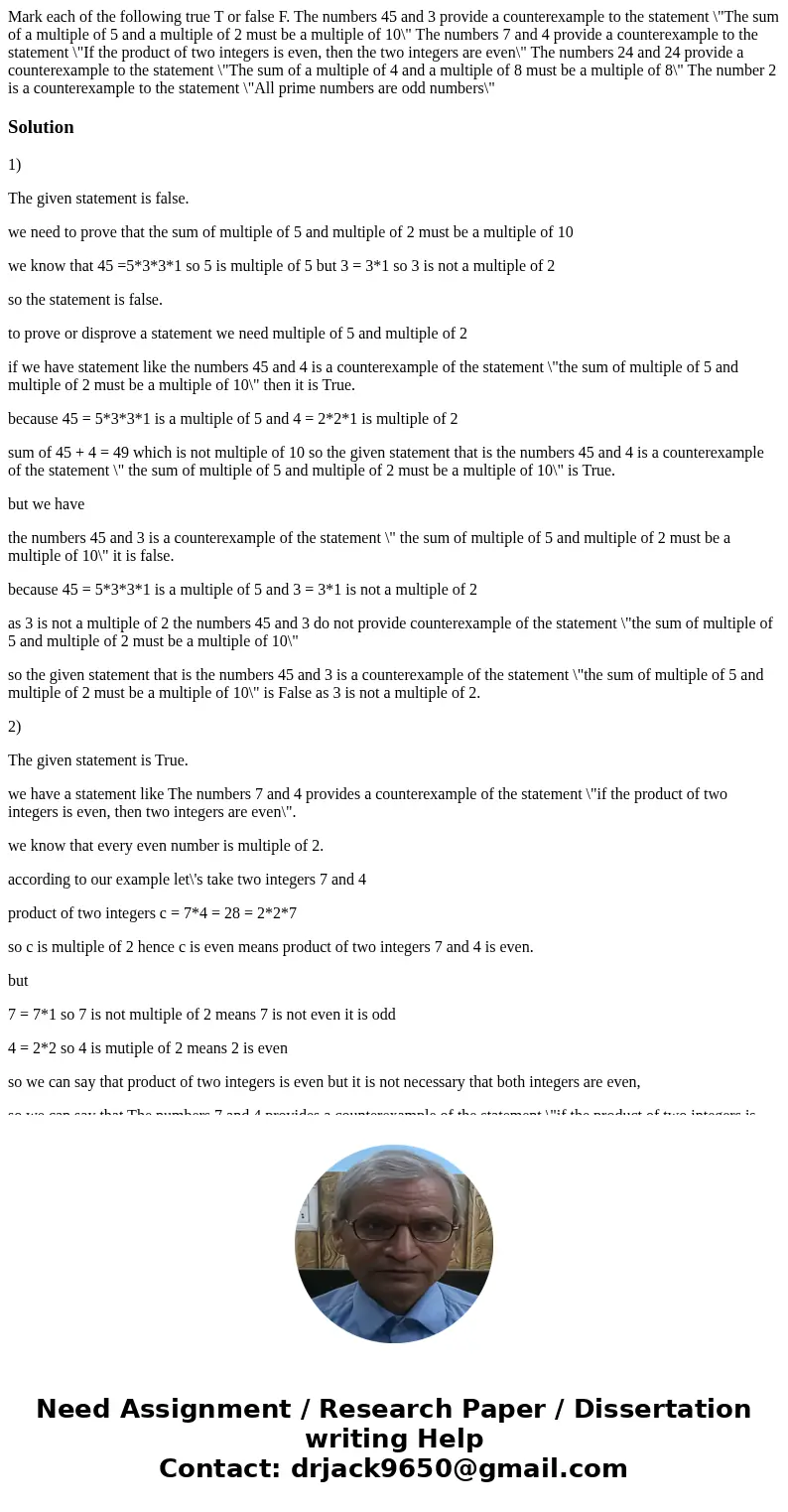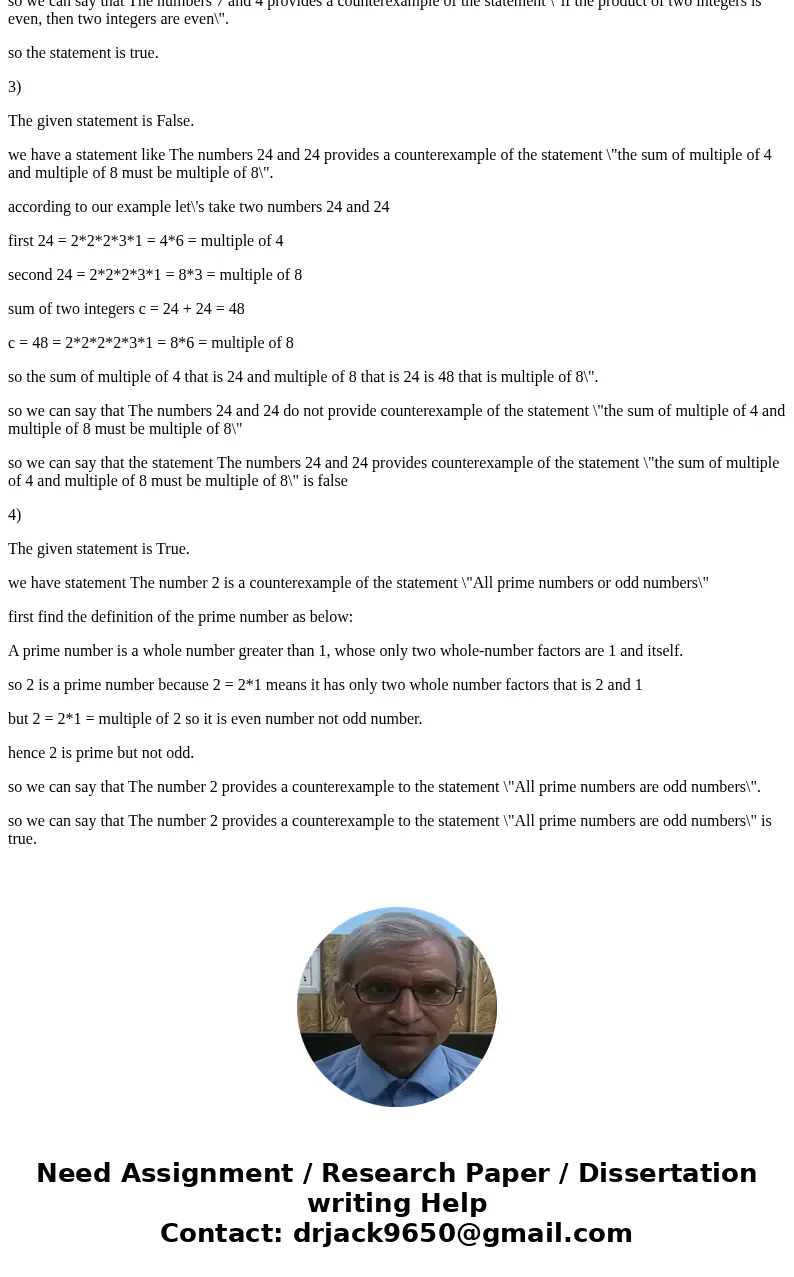Mark each of the following true T or false F The numbers 45
Solution
1)
The given statement is false.
we need to prove that the sum of multiple of 5 and multiple of 2 must be a multiple of 10
we know that 45 =5*3*3*1 so 5 is multiple of 5 but 3 = 3*1 so 3 is not a multiple of 2
so the statement is false.
to prove or disprove a statement we need multiple of 5 and multiple of 2
if we have statement like the numbers 45 and 4 is a counterexample of the statement \"the sum of multiple of 5 and multiple of 2 must be a multiple of 10\" then it is True.
because 45 = 5*3*3*1 is a multiple of 5 and 4 = 2*2*1 is multiple of 2
sum of 45 + 4 = 49 which is not multiple of 10 so the given statement that is the numbers 45 and 4 is a counterexample of the statement \" the sum of multiple of 5 and multiple of 2 must be a multiple of 10\" is True.
but we have
the numbers 45 and 3 is a counterexample of the statement \" the sum of multiple of 5 and multiple of 2 must be a multiple of 10\" it is false.
because 45 = 5*3*3*1 is a multiple of 5 and 3 = 3*1 is not a multiple of 2
as 3 is not a multiple of 2 the numbers 45 and 3 do not provide counterexample of the statement \"the sum of multiple of 5 and multiple of 2 must be a multiple of 10\"
so the given statement that is the numbers 45 and 3 is a counterexample of the statement \"the sum of multiple of 5 and multiple of 2 must be a multiple of 10\" is False as 3 is not a multiple of 2.
2)
The given statement is True.
we have a statement like The numbers 7 and 4 provides a counterexample of the statement \"if the product of two integers is even, then two integers are even\".
we know that every even number is multiple of 2.
according to our example let\'s take two integers 7 and 4
product of two integers c = 7*4 = 28 = 2*2*7
so c is multiple of 2 hence c is even means product of two integers 7 and 4 is even.
but
7 = 7*1 so 7 is not multiple of 2 means 7 is not even it is odd
4 = 2*2 so 4 is mutiple of 2 means 2 is even
so we can say that product of two integers is even but it is not necessary that both integers are even,
so we can say that The numbers 7 and 4 provides a counterexample of the statement \"if the product of two integers is even, then two integers are even\".
so the statement is true.
3)
The given statement is False.
we have a statement like The numbers 24 and 24 provides a counterexample of the statement \"the sum of multiple of 4 and multiple of 8 must be multiple of 8\".
according to our example let\'s take two numbers 24 and 24
first 24 = 2*2*2*3*1 = 4*6 = multiple of 4
second 24 = 2*2*2*3*1 = 8*3 = multiple of 8
sum of two integers c = 24 + 24 = 48
c = 48 = 2*2*2*2*3*1 = 8*6 = multiple of 8
so the sum of multiple of 4 that is 24 and multiple of 8 that is 24 is 48 that is multiple of 8\".
so we can say that The numbers 24 and 24 do not provide counterexample of the statement \"the sum of multiple of 4 and multiple of 8 must be multiple of 8\"
so we can say that the statement The numbers 24 and 24 provides counterexample of the statement \"the sum of multiple of 4 and multiple of 8 must be multiple of 8\" is false
4)
The given statement is True.
we have statement The number 2 is a counterexample of the statement \"All prime numbers or odd numbers\"
first find the definition of the prime number as below:
A prime number is a whole number greater than 1, whose only two whole-number factors are 1 and itself.
so 2 is a prime number because 2 = 2*1 means it has only two whole number factors that is 2 and 1
but 2 = 2*1 = multiple of 2 so it is even number not odd number.
hence 2 is prime but not odd.
so we can say that The number 2 provides a counterexample to the statement \"All prime numbers are odd numbers\".
so we can say that The number 2 provides a counterexample to the statement \"All prime numbers are odd numbers\" is true.


 Homework Sourse
Homework Sourse